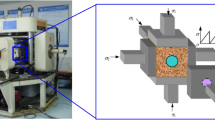Abstract
Mine developments such as haulage drifts and their intersections with cross-cuts are the only stope access in sub-level stoping mining system. Thus, they must remain stable during their service life. Haulage drift instability could lead to serious consequences such as: production delay, damage to equipment, loss of reserves and high operational cost. The goal of this paper is the stability of mine developments with respect to mining sequence with focus on the performance of haulage drift intersection during the production plan. A case study, the #1 Shear East orebody at Vale’s Garson Mine in Sudbury Ontario will be examined in this paper. A three-dimensional, elastoplastic, finite difference code (FLAC3D) is used for this study. The extent of strength-to-stress ratio corresponds to Mohr–Coulomb strength-to-stress ratio of 1.4 is used as failure evaluation criterion. The unsatisfactory performance is reached when the extent of strength-to-stress ratio exceeds the anchorage limit of the rockbolt. Stochastic analysis; adopting point-estimate method, is then employed with the numerical modelling to tackle the inherent uncertainty associated with rockmass properties. Then, the probability of instability at various mining steps is estimated for the roof and north wall of the studied intersection. The cost of consequence models is introduced to provide an economical solution if the intersection failed, blocked or damaged. Furthermore, the geotechnical risk associated with the instability of mine development intersection is estimated using risk-indexing tool. The results are presented and categorized in terms of probability, cost of consequence and risk-index at various mining stages.















Similar content being viewed by others
Abbreviations
- C:
-
Cohesion
- γ:
-
Unit weight
- υ:
-
Poisson’s ratio
- E:
-
Modulus of of elasticity
- Φ:
-
Friction angle
- ψ:
-
Dilation angle
- σt :
-
Tensile strength
- GSI:
-
Geological strength index
- Q:
-
Rock tunnelling quality index
- δ:
-
Coefficient of variation = \(\frac{\upsigma}{\upmu}\)
- μ:
-
Mean or average value or rockmass
- σ:
-
Standard deviation
- σ1 :
-
Major principal stress (compressive stresses are taken as negative)
- σ2 :
-
Intermediate principal stress
- σ3 :
-
Minor principal stress (vertical stress = γ·H)
- G(X):
-
Performance function
- R(X):
-
Resistance (represents rockmass strength)
- S(X):
-
Action (represents mining induced-stress)
- f (X):
-
Joint probability density function of the vector (X)
- Pf :
-
Probability of unsatisfactory performance
- PDF:
-
Probability density function
- CC:
-
Cost of consequence
References
Abdellah W, Mitri HS, Thibodeau D, Moreau-Verlaan L (2012) Stochastic evaluation of haulage drift unsatisfactory performance using random Monte–Carlo simulation. Int J Min Miner Eng 4(1):63–87
Abdellah W, Mitri HS et al (2013) Stochastic stability analysis of mine developments with respect to planned mining sequence. Int J Rock Mech Min Sci Submitt
Bawden WF, Tod J, Lausch P, Davison G (2002) ‘The use of geomechanical instrumentation in cost control in underground mining’. 1st deep and high stress mining seminar. Perth, Western Australia
Bewick RP, Valley B (2009) Global approach to managing deep mining hazards. ROCKENG09: Diederichs M, Grasselli G (eds) Proceedings of the 3rd CANUS rock mechanics symposium, Toronto, May 2009
Charette F (2012) ‘Monitoring of dynamic bolts for high stress mining’. Paper presented at In: Proceedings of 21st Canadian rock mechanics symposium, RockEng12
Christian JT, Baecher BG (1999) Point estimate method as numerical quadrature. J Geotech Geoenviron Eng 125(9):779–786
Golder Associate and MIRARCO (2008). Draft report on: Garson mine geomechanical study 12
Hoek E, Brown ET (1980) Empirical strength criterion for rock masses. J Geotech Eng Div ASCE 106(GT9):1013–1035
ITASCA, Fast Lagrangian Analysis of Continua in 3 Dimensions (FLAC3D),user’s manual ver. 4.0, Itasca Consulting Group Inc, Minneapolis, Minnesota 55401 USA, 2009
Kwangho Y, Yeonjun P et al (2005) Risk analysis for determination of a tunnel support pattern. Tunn Undergr Space Technol 20:479–486
Maloney S, Cai M (2006) In situ stress determination, Garson Mine, Project Report: 06-015, Geomechanics Research Center, MIRARCO
McKinnon SD (2001) Analysis of stress measurements using a numerical model methodology. Int J Rock Mech Min Sci (IJRMMS) 38:699–709
Musunuri A, Wei W, et al. (2009) Assessment of drift stability using probability of failure. In: Mehrotra A, FK, HG, Singhal RK, Banff AB (eds) Proceedings of the eighteenth international symposium on mine planning and equipment selection. pp 987–996
Perman F, Sjöberg J, et al. (2011) Detailed three-dimensional stress analysis of complex orebody geometry–model setup and results for the Malmberget mine. In: Continuum and distinct element numerical modeling in geomechanics Itasca international inc, Minneapolis
Schweiger HF, Thurner R (2007) Basic concept and applications of point estimate methods in geotechnical engineering. pp 97–112
Shnorhokian S, Mitri HS, Thibodeau D (2014) Numerical simulation of pre-mining stress field in a heterogeneous rock mass. Int J Rock Mech Min Sci. doi:10.1016/j.ijrmms.2013.12.002
Vale Inco Limited—Garson Deep Pre-Feasibility Study/FEL 2. Geotechnical Report. Feb 2009
Valley B, Kaiser PK, Duff D (2010) Consideration of uncertainty in modelling the behaviour of underground excavations”. In: Van Sint Jan M, Potvin Y (eds) Deep mining: 5th international seminar on deep and high stress mining, Santiago, Chile. Australian Centre for Geomechanics. pp 423–436
Wei W, Mitri HS, Kelly C (2012) ‘Evaluating immediate mining induced ground movement the performance of the primary support system’. Paper presented at In: Proceedings of 21st Canadian rock mechanics symposium, RockEng12
Zhang Y, Mitri HS (2008) Elastoplastic stability analysis of mine haulage drift in the vicinity of mined stopes. Int J Rock Mech Min Sci (IJRMMS) 45:574–593
Acknowledgments
This work is financially supported by a research grant from the Natural Sciences and Engineering Research Council of Canada in partnership with Vale ltd. The authors are grateful for their support.
Author information
Authors and Affiliations
Corresponding author
Rights and permissions
About this article
Cite this article
Abdellah, W., Mitri, H.S., Thibodeau, D. et al. Geotechnical Risk Assessment of Mine Development Intersections with Respect to Mining Sequence. Geotech Geol Eng 32, 657–671 (2014). https://doi.org/10.1007/s10706-014-9742-y
Received:
Accepted:
Published:
Issue Date:
DOI: https://doi.org/10.1007/s10706-014-9742-y




